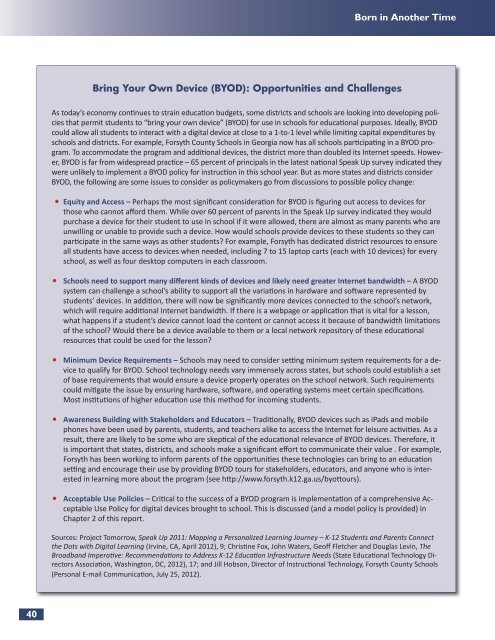Create successful ePaper yourself
Turn your PDF publications into a flip-book with our unique Google optimized e-Paper software.
40<br />
Bring Your Own Device (BYOD): Opportunities and Challenges<br />
Born in Another Time<br />
As today’s economy con� nues to strain educa� on budgets, some districts and schools are looking into developing policies<br />
that permit students to “bring your own device” (BYOD) for use in schools for educa� onal purposes. Ideally, BYOD<br />
could allow all students to interact with a digital device at close to a 1-to-1 level while limi� ng capital expenditures by<br />
schools and districts. For example, Forsyth County Schools in Georgia now has all schools par� cipa� ng in a BYOD program.<br />
To accommodate the program and addi� onal devices, the district more than doubled its Internet speeds. However,<br />
BYOD is far from widespread prac� ce – 65 percent of principals in the latest na� onal Speak Up survey indicated they<br />
were unlikely to implement a BYOD policy for instruc� on in this school year. But as more states and districts consider<br />
BYOD, the following are some issues to consider as policymakers go from discussions to possible policy change:<br />
Equity and Access – Perhaps the most signifi cant considera� on for BYOD is fi guring out access to devices for<br />
those who cannot aff ord them. While over 60 percent of parents in the Speak Up survey indicated they would<br />
purchase a device for their student to use in school if it were allowed, there are almost as many parents who are<br />
unwilling or unable to provide such a device. How would schools provide devices to these students so they can<br />
par� cipate in the same ways as other students? For example, Forsyth has dedicated district resources to ensure<br />
all students have access to devices when needed, including 7 to 15 laptop carts (each with 10 devices) for every<br />
school, as well as four desktop computers in each classroom.<br />
Schools need to support many diff erent kinds of devices and likely need greater Internet bandwidth – A BYOD<br />
system can challenge a school’s ability to support all the varia� ons in hardware and so� ware represented by<br />
students’ devices. In addi� on, there will now be signifi cantly more devices connected to the school’s network,<br />
which will require addi� onal Internet bandwidth. If there is a webpage or applica� on that is vital for a lesson,<br />
what happens if a student’s device cannot load the content or cannot access it because of bandwidth limita� ons<br />
of the school? Would there be a device available to them or a local network repository of these educa� onal<br />
resources that could be used for the lesson?<br />
Minimum Device Requirements – Schools may need to consider se� ng minimum system requirements for a device<br />
to qualify for BYOD. School technology needs vary immensely across states, but schools could establish a set<br />
of base requirements that would ensure a device properly operates on the school network. Such requirements<br />
could mi� gate the issue by ensuring hardware, so� ware, and opera� ng systems meet certain specifi ca� ons.<br />
Most ins� tu� ons of higher educa� on use this method for incoming students.<br />
Awareness Building with Stakeholders and Educators – Tradi� onally, BYOD devices such as iPads and mobile<br />
phones have been used by parents, students, and teachers alike to access the Internet for leisure ac� vi� es. As a<br />
result, there are likely to be some who are skep� cal of the educa� onal relevance of BYOD devices. Therefore, it<br />
is important that states, districts, and schools make a signifi cant eff ort to communicate their value . For example,<br />
Forsyth has been working to inform parents of the opportuni� es these technologies can bring to an educa� on<br />
se� ng and encourage their use by providing BYOD tours for stakeholders, educators, and anyone who is interested<br />
in learning more about the program (see h� p://www.forsyth.k12.ga.us/byo� ours).<br />
Acceptable Use Policies – Cri� cal to the success of a BYOD program is implementa� on of a comprehensive Acceptable<br />
Use Policy for digital devices brought to school. This is discussed (and a model policy is provided) in<br />
Chapter 2 of this report.<br />
Sources: Project Tomorrow, Speak Up 2011: Mapping a Personalized Learning Journey – K-12 Students and Parents Connect<br />
the Dots with Digital Learning (Irvine, CA, April 2012), 9; Chris� ne Fox, John Waters, Geoff Fletcher and Douglas Levin, The<br />
Broadband Impera� ve: Recommenda� ons to Address K-12 Educa� on Infrastructure Needs (State Educa� onal Technology Directors<br />
Associa� on, Washington, DC, 2012), 17; and Jill Hobson, Director of Instruc� onal Technology, Forsyth County Schools<br />
(Personal E-mail Communica� on, July 25, 2012).


